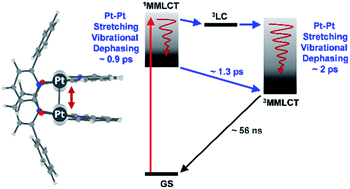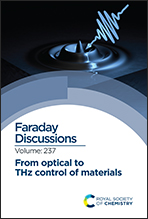Ultrafast branching in intersystem crossing dynamics revealed by coherent vibrational wavepacket motions in a bimetallic Pt(ii) complex†
Abstract
Ultrafast excited state processes of transition metal complexes (TMCs) are governed by complicated interplays between electronic and nuclear dynamics, which demand a detailed understanding to achieve optimal functionalities of photoactive TMC-based materials for many applications. In this work, we investigated a cyclometalated platinum(II) dimer known to undergo a Pt–Pt bond contraction in the metal–metal-to-ligand-charge-transfer (MMLCT) excited state using femtosecond broadband transient absorption (fs-BBTA) spectroscopy in combination with geometry optimization and normal mode calculations. Using a sub-20 fs pump and broadband probe pulses in fs-BBTA spectroscopy, we were able to correlate the coherent vibrational wavepacket (CVWP) evolution with the stimulated emission (SE) dynamics of the 1MMLCT state. The results demonstrated that the 145 cm−1 CVWP motions with the damping times of ∼0.9 ps and ∼2 ps originate from coherent Pt–Pt stretching vibrations in the singlet and triplet MMLCT states, respectively. On the basis of excited state potential energy surface calculations in our previous work, we rationalized that the CVWP transfer from the Franck–Condon (FC) state to the 3MMLCT state was mediated by a triplet ligand-centered (3LC) intermediate state through two step intersystem crossing (ISC) on a time scale shorter than a period of the Pt–Pt stretching wavepacket motions. Moreover, it was found that the CVWP motion had 110 cm−1 frequency decays with the damping time of ∼0.2 ps, matching the time constant of 0.253 ps, corresponding to a redshift in the SE feature at early times. This observation indicates that the Pt–Pt bond contraction changes the stretching frequency from 110 to 145 cm−1 and stabilizes the 1MMLCT state relative to the 3LC state with a ∼0.2 ps time scale. Thus, the ultrafast ISC from the 1MMLCT to the 3LC states occurs before the Pt–Pt bond shortening. The findings herein provide insight into understanding the impact of Pt–Pt bond contraction on the ultrafast branching of the 1MMLCT population into the direct (1MMLCT → 3MMLCT) and indirect ISC pathways (1MMLCT → 3LC → 3MMLCT) in the Pt(II) dimer. These results revealed intricate excited state electronic and nuclear motions that could steer the reaction pathways with a level of detail that has not been achieved before.

- This article is part of the themed collection: From optical to THz control of materials


 Please wait while we load your content...
Please wait while we load your content...